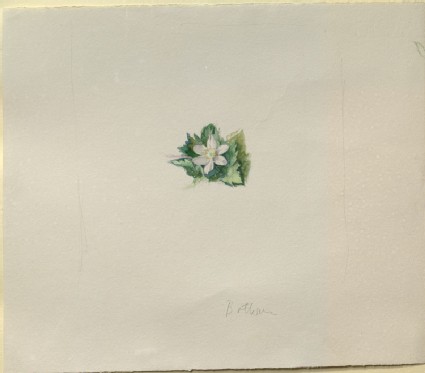Browse: 1470 objects
- Reference URL
Actions
Sketch of a Wood Anemone John Ruskin
-
Details
- Artist/maker
-
John Ruskin (1819 - 1900)
- Object type
- drawing
- Material and technique
- watercolour over graphite on wove paper
- Dimensions
- 278 x 323 mm
- Inscription
- Recto, near bottom centre, in graphite: Bottom
Verso:
top, left of centre, in graphite: R. 251
towards bottom centre: Bottom
centre, the Ruskin School's stamp
- Provenance
-
Presented by John Ruskin to the Ruskin Drawing School (University of Oxford), 1875; transferred from the Ruskin Drawing School to the Ashmolean Museum, c.1949.
- No. of items
- 1
- Accession no.
- WA.RS.RUD.251.a
-
Subject terms allocated by curators:
Subjects
-
References in which this object is cited include:
References
Taylor, Gerald, ‘John Ruskin: A Catalogue of Drawings by John Ruskin in the Ashmolean Museum, Oxford’, 7 fascicles, 1998, Oxford, Ashmolean Museum, no. 233
Ruskin, John, The Ruskin Art Collection at Oxford: Catalogue of the Rudimentary Series, in the Arrangement of 1873, ed. Robert Hewison (London: Lion and Unicorn Press, 1984), cat. Rudimentary no. 251.a, RUD.251.a
Ruskin, John, ‘Educational Series 1878’, 1878, Oxford, Oxford University Archives, cat. Educational no. 16
Ruskin, John, Instructions in Practice of Elementary Drawing, Arranged with Reference to the First Series of Examples in the Drawings Schools of the University of Oxford (n.p., [1872]), cat. Rudimentary no. 251
Ruskin, John, Instructions in the Preliminary Exercises Arranged for the Lower Drawing-School (London: Smith, Elder, 1872), cat. Rudimentary no. 251
Ruskin, John, Instructions in the Preliminary Exercise Arranged For the Lower Drawing-School (London: Spottiswoode, 1873), cat. Rudimentary no. 251
Ruskin, John, ‘The Ruskin Art Collection at Oxford: Catalogues, Notes and Instructions’, Edward T. Cook and Alexander Wedderburn, eds, The Works of John Ruskin: Library Edition, 39 (London: George Allen, 1903-1912), 21, cat. Rudimentary no. 251
Location
-
- Western Art Print Room
Position in Ruskin’s Collection
Ruskin's Catalogues
-
Educational, manuscript (1878)
16.The wood-anemone, showing its relation to its triangular leaf. Beneath, a little study of fruit and leaf, by Miss Dundas; which I place here as entirely standard. It is perfectly easy and perfectly complete, and in qualities of actual realisation, without reference to those of design, neither Durer nor any one else could do much better.
-
Ruskin's Rudimentary series, 3rd ed. (1872)
These are chiefly for temporary service, though some will be permanently placed, but otherwise arranged. Their purpose is to enforce the practice of making the shade subordinate to the colour, and the greater number of them are Venetian, 15th century, most admirably copied by M. Caldara, and entirely authoritative as to the Venetian practice in this respect.
In R|251 my sketch of wood anemone gives the simplest beginning of leaf colour, green and white; and the drawing beneath of a leaf of Berberis Mahonia, by a pupil of my assistant, Mr. Ward, is consummate in finished texture, and, for work to be seen near, is as good as can be. The last seven drawings, in the old English manner, by Mr. Hart, are exemplary in tranquil care and respect for local colour; see the ripe and unripe mulberries, R|275, but as compared with the Venetian work, show the constant English fault of mechanical precision instead of design.
-
Ruskin's Rudimentary series, 5th ed. (1873)
These are chiefly for temporary service, though some will be permanently placed, but otherwise arranged. Their purpose is to enforce the practice of making the shade subordinate to the colour, and the greater number of them are Venetian, 15th century, most admirably copied by M. Caldara, and entirely authoritative as to the Venetian practice in this respect.
In R|251 my sketch of wood anemone gives the simplest beginning of leaf colour, green and white; and the drawing beneath of a leaf of Berberis Mahonia, by a pupil of my assistant, Mr. Ward, is consummate in finished texture, and, for work to be seen near, is as good as can be. The last seven drawings, in the old English manner, by Mr. Hart, (presented to me by one of my pupils, for this collection) are exemplary in tranquil care and respect for local colour; see the ripe and unripe mulberries, R|275, but as compared with the Venetian work, show the constant English fault of mechanical precision instead of design.





